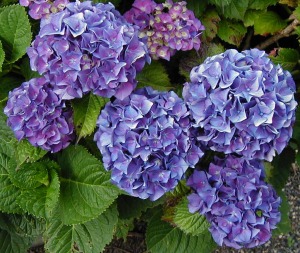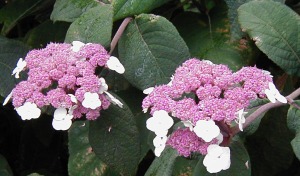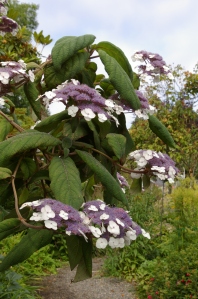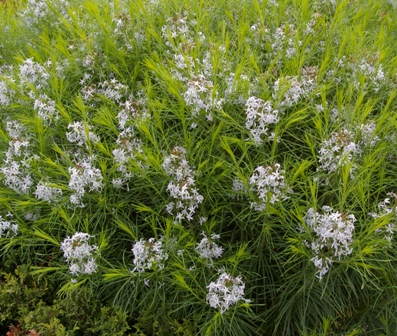In case you missed the Hydrangea tour and talk with Maurice last weekend, here are a few highlights.
 The crowd favorite of the tour was ‘Merritt’s Supreme’. This Hydrangea is in the macrophylla family which includes plants with the classic mophead flower shape. The color in our garden is especially striking, being an intense blue fading to purple. Remember, hydrangea’s will change flower color with different soil pH: 5.0-5.5 for blue flowers and 6.0-6.5 for pink flowers. Here in the NW our soils tend towards lower, more acidic pH levels due to the high rainfall which leaches out water-soluble minerals like calcium, which raise soil pH. To keep your soil even more acidic, try adding coffee grounds, fine bark dust or sawdust around your plants.
The crowd favorite of the tour was ‘Merritt’s Supreme’. This Hydrangea is in the macrophylla family which includes plants with the classic mophead flower shape. The color in our garden is especially striking, being an intense blue fading to purple. Remember, hydrangea’s will change flower color with different soil pH: 5.0-5.5 for blue flowers and 6.0-6.5 for pink flowers. Here in the NW our soils tend towards lower, more acidic pH levels due to the high rainfall which leaches out water-soluble minerals like calcium, which raise soil pH. To keep your soil even more acidic, try adding coffee grounds, fine bark dust or sawdust around your plants.
The group also looked at the less common Hydrangea aspera. The latin ‘aspera’ means “rough-textured” and refers to the downy underside of the leaves. The aspera complex of hydrangeas is rich in species and selections of underused shrubs for our borders. We have several in our collection.  Hydrangea aspera ‘Macrophylla’ (Big-leaf Chinese Hydrangea) is an exceptionally attractive large shrub. It recently gained the Royal Horticultural Society’s Award of Garden Merit. The lacecap flowerheads are proportionate in scale and domed. Good-sized, antique white sterile florets encircle the sizable, fuzzy looking cluster of fertile florets. The “macro” leaves referred to in the cultivar name are a good 10 inches in width and are covered with a felt-like layer of fine hairs. This felting is echoed in the young wood as well where new growth is similar to the velvet on a deer’s antlers.
Hydrangea aspera ‘Macrophylla’ (Big-leaf Chinese Hydrangea) is an exceptionally attractive large shrub. It recently gained the Royal Horticultural Society’s Award of Garden Merit. The lacecap flowerheads are proportionate in scale and domed. Good-sized, antique white sterile florets encircle the sizable, fuzzy looking cluster of fertile florets. The “macro” leaves referred to in the cultivar name are a good 10 inches in width and are covered with a felt-like layer of fine hairs. This felting is echoed in the young wood as well where new growth is similar to the velvet on a deer’s antlers.  Hydrangea aspera var. robusta is magnificent and somewhat mysterious in appearance. This selection of Hydrangea aspera has immense wooly leaves that are just shy of a foot long and five inches wide. Purple leaf petioles add to the allure of the plant. In addition, the matte green leaves recurve along their edges as if trying to imitate the rounded shape of the large, six-inch lace-cap inflorescences. The fertile flowers are lavender pink and fuzzy in appearance. They are surrounded by white sterile florets consisting of four (occasionally 3 or 5) sepals. The flowering stems are covered in velvet like that on deer’s antlers. The rust colored bark on the older branches defoliates much as birchbark does.
Hydrangea aspera var. robusta is magnificent and somewhat mysterious in appearance. This selection of Hydrangea aspera has immense wooly leaves that are just shy of a foot long and five inches wide. Purple leaf petioles add to the allure of the plant. In addition, the matte green leaves recurve along their edges as if trying to imitate the rounded shape of the large, six-inch lace-cap inflorescences. The fertile flowers are lavender pink and fuzzy in appearance. They are surrounded by white sterile florets consisting of four (occasionally 3 or 5) sepals. The flowering stems are covered in velvet like that on deer’s antlers. The rust colored bark on the older branches defoliates much as birchbark does.
Overall it was a fantastic tour and a unique opportunity to spend a few hours with Joy Creek Nursery owner, Maurice Horn in the garden.
Looking forward to next week’s class ‘Cuts from the Garden’ with our plant propagator, entomologist and plant pathologist, Leslie Glover. She will talk about ways to use all aspects of your garden to create beautiful cut flower arrangements. Hope to see you there!







